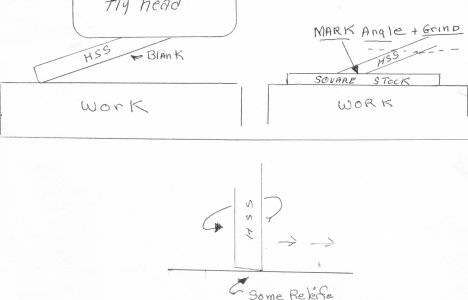- Joined
- Feb 2, 2013
- Messages
- 3,627
Hello Friends,
When removing material from stock on a mill, i have never used a fly cutter.
I have always used end mills of varying dimensions.
none of my experience is in a production setting.
mainly, one off reproductions for replacement of factory components, either no longer available or way to costly to consider having some one else make them.
I try very hard to get materials that are factory quality or (in my sole estimation) better than OEM materials.
I've had a problem for years on a particular brand of saw that is very well made but has 2 Achilles' heels
#1 Cost, it's very expensive in it's market and is an industrial quality piece of equipment.
#2 Use of Derlin parts where metals should be used.
Which brings me around to my point....
I'm in the process of reproducing one of the Achilles' heels out of 6061 Aluminum Bar from material i'm going to re-purpose.
the material is 2 1/2" Square and i need to remove approximately 35% total material from 2 faces.
i considered using a large endmill and just goin' at it, but i have a set of fly cutters that accept square bits
i have not used a fly cutter ever, and i want to remove more material per pass.
secondary to that i would like to learn how to grind the tool correctly for flycutting.
i'm proficient at grinding HSS blanks for the lathe, but i'll admit i have no idea how to do it for the mill.
rather than damage my work piece or wreck something else i thought i'd ask the gentry here.
I'm sure i'm not the only one who doesn't know, maybe it will help someone else as well...
Thank you in for taking the time to read and post your explanations
mike )
)
When removing material from stock on a mill, i have never used a fly cutter.
I have always used end mills of varying dimensions.
none of my experience is in a production setting.
mainly, one off reproductions for replacement of factory components, either no longer available or way to costly to consider having some one else make them.
I try very hard to get materials that are factory quality or (in my sole estimation) better than OEM materials.
I've had a problem for years on a particular brand of saw that is very well made but has 2 Achilles' heels
#1 Cost, it's very expensive in it's market and is an industrial quality piece of equipment.
#2 Use of Derlin parts where metals should be used.
Which brings me around to my point....
I'm in the process of reproducing one of the Achilles' heels out of 6061 Aluminum Bar from material i'm going to re-purpose.
the material is 2 1/2" Square and i need to remove approximately 35% total material from 2 faces.
i considered using a large endmill and just goin' at it, but i have a set of fly cutters that accept square bits
i have not used a fly cutter ever, and i want to remove more material per pass.
secondary to that i would like to learn how to grind the tool correctly for flycutting.
i'm proficient at grinding HSS blanks for the lathe, but i'll admit i have no idea how to do it for the mill.
rather than damage my work piece or wreck something else i thought i'd ask the gentry here.
I'm sure i'm not the only one who doesn't know, maybe it will help someone else as well...
Thank you in for taking the time to read and post your explanations
mike


